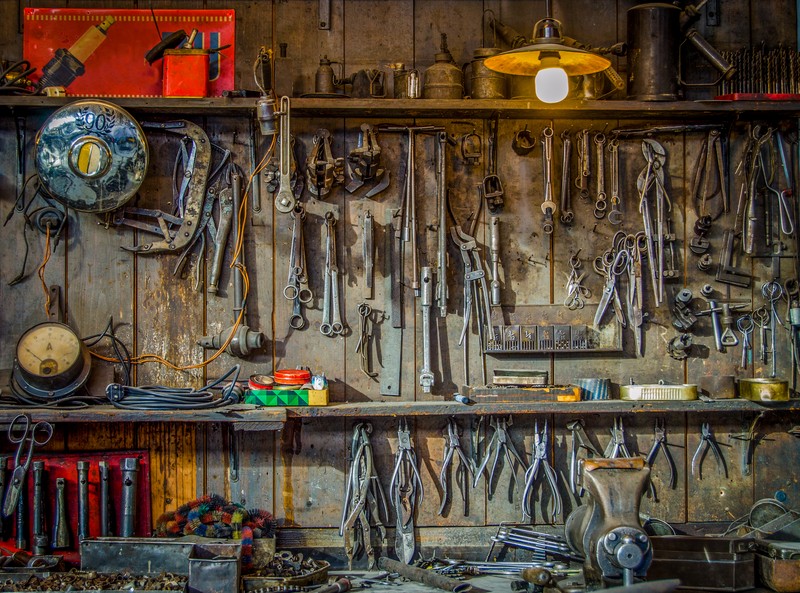Hand tools can be fun to use, if a lot of work, but in a survival situation, they might be all you have!
Here is a basic list of hand tools you should have in supply if and when you need them!
Hacksaw: Useful hand hacksaws come in two classic sizes, 10 inch blades and 12 inch.
The standard looking solid-frame hacksaw uses a 12 inch blade while the mini saw uses the 10 inch. For the price, I recommend at least one of each, and you can use 12 inch blades on the mini versions, but it’s easy to break the non-supported portion of the blade if you’re not careful. And even if you do snap it in half, just keep using whatever piece fits in the saw.
Standard Hand Saw: This is the traditional looking saw with a wood handle attached to a slightly triangular blade tapering as it goes from grip to tip. They come in various lengths and tooth sizes, and of course, price points. The useful length of a hand saw tops out at about 30 inches, but a 26 or 20 inch blade works very well for most tasks. I have a handful of 15 inch saws floating around and they work as good or better than most camp saws when you don’t need to carry the saw in your pack.
As the teeth get smaller, it is easier to cut because less material is removed with each stroke. So the there is a tradeoff between cutting speed and necessary muscle. If you are in a region with harder woods, go for a tooth count above 10. If your world is more of softer woods like the pine forests of the west, then fewer than 10 teeth per inch will serve most needs just fine. Either way, the high-carbon steel will rust and pit if left alone outside.
Large Hand Drill: Larger hand drills come in two popular designs. One looks like a bigger version of the standard small hand drill which is little more than a vertical shaft with a geared-crank wheel attached to the center, a handle above it, and a chuck below it. The other design called a brace drill looks like a bowed shaft of metal with a chuck on one end, a spin-able knob on the other and a rotating grip in the middle. Either design will allow you to place a considerable portion of your body weight on the shaft while drilling, but the cost of the more complex geared version increases exponentially as it goes up in size.
Brace drills are much less expensive and often have a ratchet mechanism like a socket that allows drilling in confined spaces where a complete revolution of the offset handle is not possible. Most brace drills have chucks that take up to half-inch bit shafts, but reduced-shaft wood bits give your brace drill up to a two inch diameter drilling capacity assuming you have a bit that size, let alone a need for a hole that big and the time to drill it.
Hand-powered Grinding Wheel: From plow blades to hatchet heads, nothing makes sharpening large metal easier than moving the stone instead of the blade. Even at just a few hundred RPMs, the spinning stone will spit enough sparks to set your shop on fire if you’re not careful.
The spinning inertia of a hand-powered grinding wheel is only enough to do very small tasks. For any job of substance, the cranking must accompany the grinding so for those times, which happens to be all the time, an additional hand or two is helpful. And spinning the grinding wheel might be the most post-apocalyptic fun a kid can have.
Due to the extremely high chance that a speck of stone or metal will fly into your eye, your kid’s eye, or your dog’s eye, exercise caution by putting a transparent barrier between any living cornea and any remotely conceivable missile trajectory launched from the other side.
Hand-powered Air Pump: In case you didn’t know it, you can use a bicycle air pump to inflate a car tire. It will take you a long time, but nothing is preventing it except maybe the wrong valve connector which is an easy fix. Motorized vehicles use relatively low-pressure tires with cars, trucks and motorcycle tire manufacturers suggesting something in the 25-45 psi range. But vehicle tires are also incredibly high volume spaces to fill compared to bicycle tires. Most bike pumps are designed for lower volume but much higher pressures, some over 200 psi. Either way, you’re SOL if all you’ve got is one air compressor and zero electricity. No matter how many hours of pumping it takes, a bike pump will get the job done. Raft pumps, on the other hand, are designed very high volume but extremely low pressures like 2 psi, so don’t bother going there except for air mattresses, and rafts of course.
You can buy most hand tools at a hardware or home improvement store, but a more fun way of procuring them is to visit yard sales.
It is likely a yard sale hand tool will be less expensive, is much more fun to track down and if you have a significant other or spouse that likes yard sales, it is a great way to spend time together doing something you might not otherwise do.
To see a complete list of hand tools every survivalist should have, check out the Survival Cache!
